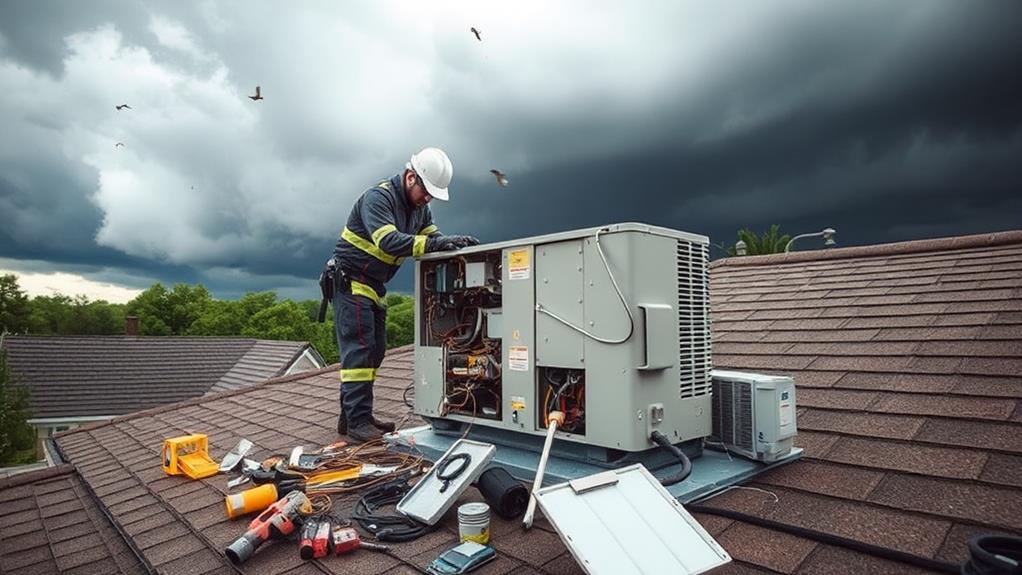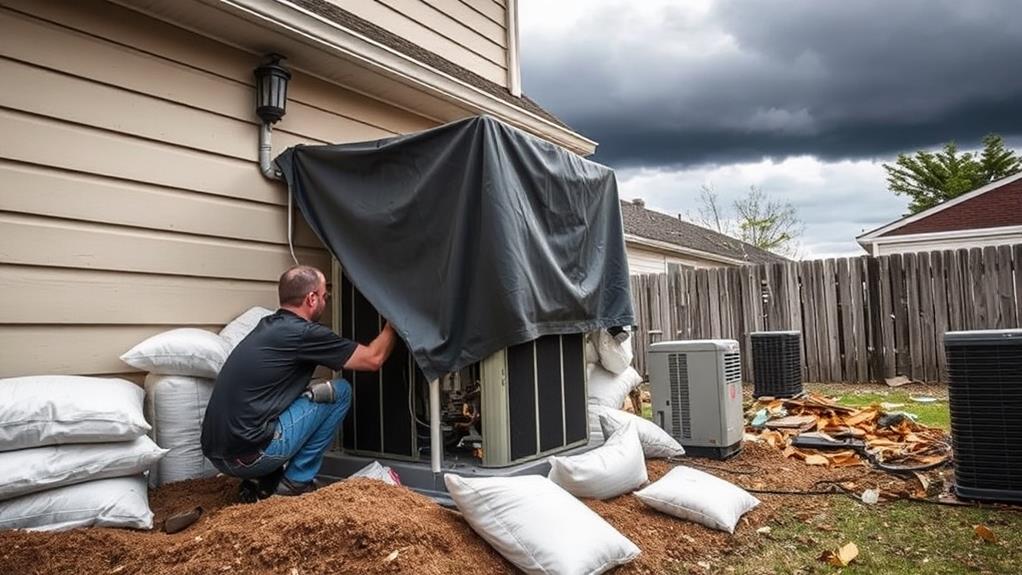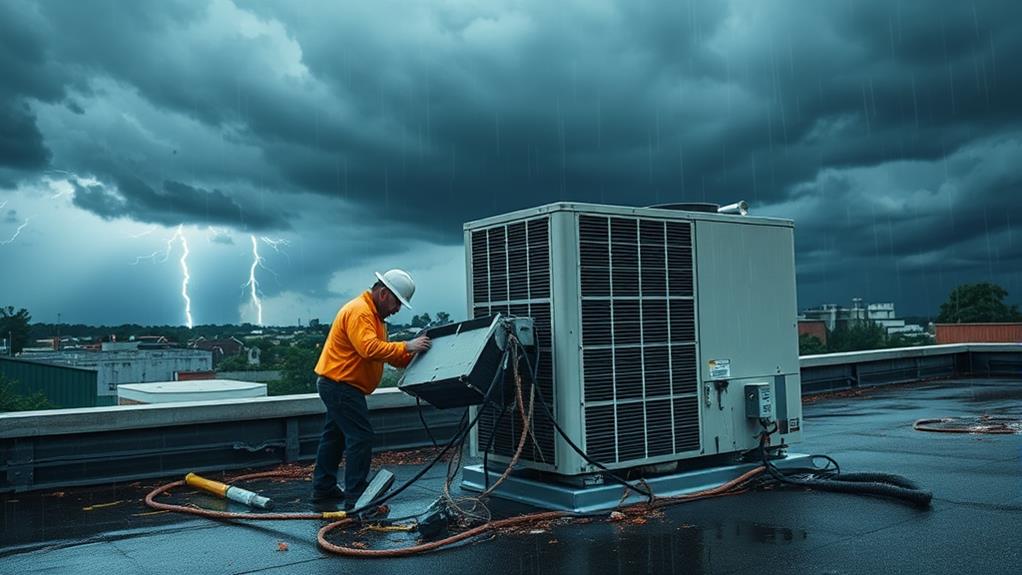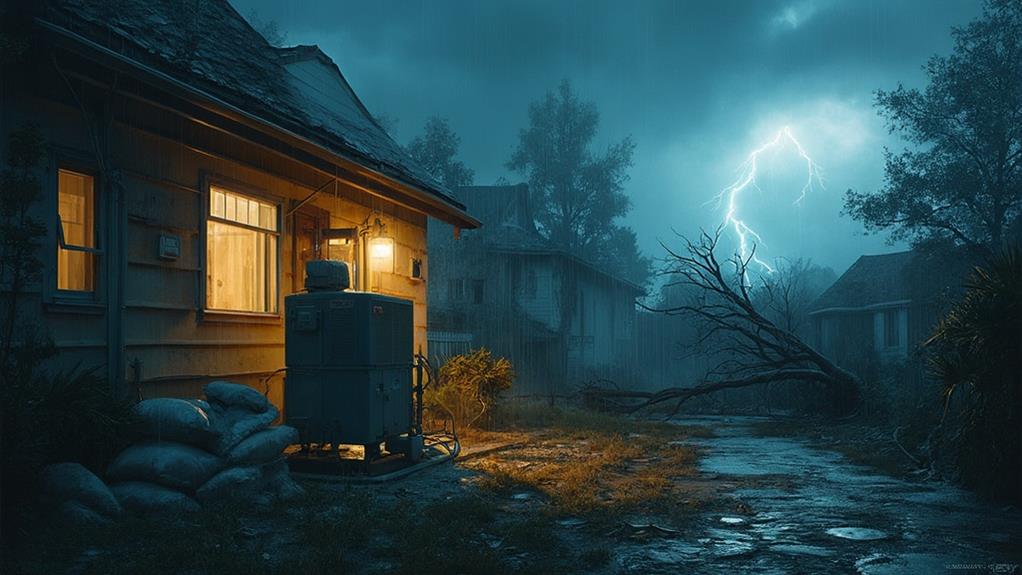Protecting HVAC systems from severe storms requires proactive measures and swift post-storm actions. Before a storm, secure outdoor units, clear debris, and schedule professional inspections. Familiarize yourself with emergency shut-off procedures and document system details. Weatherproof your HVAC system by sealing gaps, elevating units in flood-prone areas, and installing surge protectors. After the storm, conduct a thorough inspection, addressing water damage and checking for loose components. Troubleshoot common issues like debris removal and thermostat settings. For complex problems, consult a qualified HVAC technician. By following these preparation and recovery tips, you'll be better equipped to safeguard your HVAC system against nature's fury.
Pre-Storm HVAC Maintenance Checklist

Preparedness is key when it comes to protecting your HVAC system from storm damage. To ensure your system is ready to withstand severe weather, follow this pre-storm maintenance checklist:
- Inspect and secure outdoor units: Check for loose components and tighten as necessary. Ensure the unit is firmly anchored to its concrete pad.
- Clear debris: Remove leaves, branches, and other objects from around the outdoor unit to prevent clogging or damage during high winds.
- Install protective covers: Use manufacturer-approved covers to shield outdoor units from flying debris and heavy rain.
- Check and clean gutters: Ensure proper drainage to prevent water from pooling around your HVAC system.
- Trim nearby trees: Remove overhanging branches that could fall and damage your unit during a storm.
- Schedule a professional inspection: Have a certified HVAC technician perform a thorough system check to identify and address potential vulnerabilities.
- Test your system: Run your HVAC unit to ensure it's functioning correctly before the storm hits.
- Familiarize yourself with emergency shut-off procedures: Know how to safely power down your system if necessary.
- Document your system: Take photos and note model numbers for insurance purposes in case of damage.
Emergency Shut-Off Procedures
Knowing how to safely shut off your HVAC system during a storm is a critical component of your emergency preparedness plan. Familiarize yourself with the location of your system's main power switch and circuit breaker.
In the event of an impending storm, follow these steps:
- Turn off the thermostat to prevent the system from cycling on during the storm.
- Locate the main electrical panel and switch off the circuit breaker for the HVAC system.
- For gas-powered systems, locate the gas shut-off valve and turn it to the "off" position.
- If possible, cover outdoor units with a tarp or specialized HVAC cover to protect from debris.
After the storm has passed, do not immediately restart your system. First, inspect for visible damage, water intrusion, or debris. If you suspect any issues, contact a professional HVAC technician for a thorough inspection before reactivation.
When it's safe to restart:
- Remove any protective covers from outdoor units.
- Turn on the main circuit breaker for the HVAC system.
- For gas systems, carefully turn the gas valve back to the "on" position.
- Reset your thermostat to the desired temperature.
Weatherproofing Your HVAC System

Fortifying your HVAC system against severe weather is a crucial step in ensuring its longevity and performance. Start by inspecting and securing the outdoor unit. Ensure it's firmly anchored to its concrete pad and consider installing hurricane straps for added stability. Clear the surrounding area of debris, trim nearby vegetation, and remove any loose objects that could become projectiles during high winds.
Install a protective cover or cage over the outdoor unit to shield it from hail, falling branches, and other storm-related hazards. However, remember to remove these covers before operating the system to prevent overheating. Seal any gaps or cracks in your home's exterior walls where refrigerant lines enter, using weatherproof caulk or foam insulation to prevent water intrusion.
Elevate outdoor units in flood-prone areas to protect them from rising water. Consider installing a surge protector to safeguard your HVAC system's electrical components from power fluctuations during storms. Regularly clean and maintain your system, including changing filters and clearing drainage lines, to ensure optimal performance during severe weather. Finally, schedule professional inspections before storm seasons to identify and address potential vulnerabilities in your HVAC system.
Post-Storm Inspection and Assessment
After the storm passes, conducting a thorough post-storm inspection of your HVAC system is a critical step in assessing potential damage and ensuring safe operation. Begin by visually examining the outdoor unit for signs of physical damage, such as dents, bent fins, or debris accumulation. Check for water damage, particularly in basement or ground-level indoor units.
Inspect electrical connections, wiring, and control panels for any signs of corrosion or water intrusion. Evaluate the ductwork for potential breaches, water infiltration, or mold growth. Listen for unusual noises when starting the system, which may indicate internal damage. Monitor system performance, including airflow and temperature control, to identify any irregularities.
If flooding has occurred, do not attempt to operate the system until a professional assessment has been conducted. Document all observations and damage for insurance purposes. If any issues are detected, contact a qualified HVAC technician immediately. They can perform a comprehensive diagnostic check, including refrigerant levels, electrical components, and mechanical parts. Professional assessment ensures proper repairs are made and prevents further damage or safety hazards from developing.
Troubleshooting Common Storm-Related Issues

Homeowners often face a variety of HVAC issues in the aftermath of severe storms. Common problems include water damage, electrical faults, and debris-clogged components.
To address water damage, first ensure the system is completely dry before attempting to operate it. Use a wet/dry vacuum to remove standing water and a dehumidifier to reduce moisture levels. For electrical issues, check the circuit breaker and reset if necessary. If the problem persists, it may indicate more severe damage requiring professional attention.
Debris-clogged outdoor units can impair system efficiency and cause overheating. Carefully remove leaves, twigs, and other storm debris from around the unit, ensuring the fan blades and coils are clear. Strange noises post-storm may indicate loose or damaged components. Inspect for visible damage and tighten any loose screws or bolts.
If the system fails to start, check the thermostat batteries and settings. Frozen evaporator coils can result from restricted airflow; change air filters and ensure vents are unobstructed. For issues beyond basic troubleshooting, such as refrigerant leaks or compressor failure, always consult a qualified HVAC technician to prevent further damage and ensure safe operation.
Frequently Asked Questions
How Long Can an HVAC System Run on a Backup Generator?
The duration an HVAC system can run on a backup generator depends on factors such as generator capacity, fuel supply, and HVAC power requirements. Typically, a properly sized generator can support HVAC operations for several hours to several days.
Are There HVAC Systems Specifically Designed for Hurricane-Prone Areas?
In a world where hurricanes are as common as coffee breaks, HVAC manufacturers have finally caught on. Yes, hurricane-resistant HVAC systems exist, featuring reinforced casings, corrosion-resistant components, and flood-proof designs. Some even double as makeshift rafts!
Can Lightning Strikes Damage HVAC Systems Even With Surge Protectors Installed?
Lightning strikes can indeed damage HVAC systems, even with surge protectors installed. While surge protectors offer some protection, direct or nearby strikes can overwhelm these devices, potentially causing significant damage to sensitive electronic components within HVAC equipment.
How Often Should HVAC Systems Be Professionally Inspected in Storm-Prone Regions?
Prudent property owners in storm-prone regions should procure professional HVAC inspections annually. Biannual check-ups can be beneficial for added assurance. Regular reviews reduce risks, enhance efficiency, and extend equipment lifespan, ensuring optimal operation during challenging weather conditions.
What Insurance Coverage Typically Applies to Storm-Damaged HVAC Systems?
Insurance coverage for storm-damaged HVAC systems typically falls under homeowners or property insurance policies. Coverage may include repair or replacement costs, subject to deductibles and policy limits. Specific coverage varies, so reviewing individual policies is crucial.
Conclusion
Storm preparedness for HVAC systems is crucial for homeowners and businesses alike. By following a comprehensive checklist, implementing emergency procedures, and weatherproofing equipment, the impact of severe weather can be mitigated. Post-storm assessment and troubleshooting are vital steps in ensuring system integrity. Like a lighthouse guiding ships through treacherous waters, proper HVAC maintenance and storm preparation illuminate the path to resilience, safeguarding comfort and safety in the face of nature's fury.

